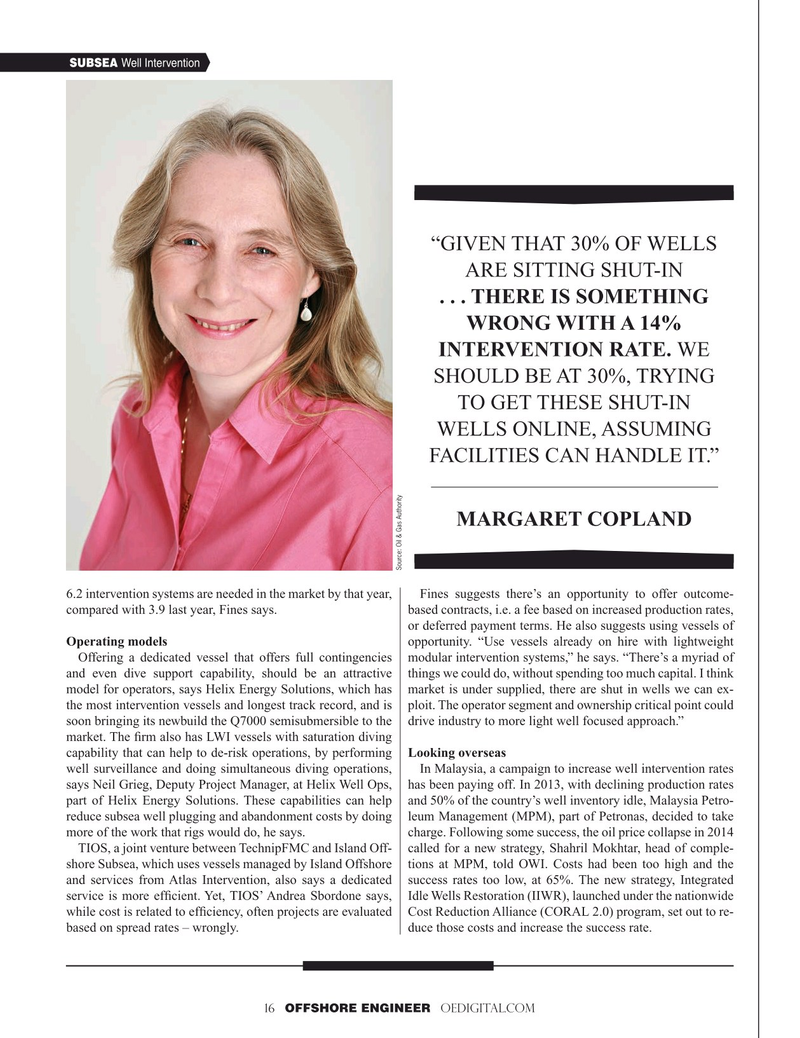
Page 16: of Offshore Engineer Magazine (Jul/Aug 2019)
Subsea Processing
Read this page in Pdf, Flash or Html5 edition of Jul/Aug 2019 Offshore Engineer Magazine
SUBSEA Well Intervention “GIVEN THAT 30% OF WELLS
ARE SITTING SHUT-IN . . . THERE IS SOMETHING
WRONG WITH A 14%
INTERVENTION RATE. WE
SHOULD BE AT 30%, TRYING
TO GET THESE SHUT-IN
WELLS ONLINE, ASSUMING
FACILITIES CAN HANDLE IT.”
MARGARET COPLAND
Source: Oil & Gas Authority 6.2 intervention systems are needed in the market by that year, Fines suggests there’s an opportunity to offer outcome- compared with 3.9 last year, Fines says. based contracts, i.e. a fee based on increased production rates, or deferred payment terms. He also suggests using vessels of
Operating models opportunity. “Use vessels already on hire with lightweight
Offering a dedicated vessel that offers full contingencies modular intervention systems,” he says. “There’s a myriad of and even dive support capability, should be an attractive things we could do, without spending too much capital. I think model for operators, says Helix Energy Solutions, which has market is under supplied, there are shut in wells we can ex- the most intervention vessels and longest track record, and is ploit. The operator segment and ownership critical point could soon bringing its newbuild the Q7000 semisubmersible to the drive industry to more light well focused approach.” market. The ? rm also has LWI vessels with saturation diving capability that can help to de-risk operations, by performing Looking overseas well surveillance and doing simultaneous diving operations, In Malaysia, a campaign to increase well intervention rates says Neil Grieg, Deputy Project Manager, at Helix Well Ops, has been paying off. In 2013, with declining production rates part of Helix Energy Solutions. These capabilities can help and 50% of the country’s well inventory idle, Malaysia Petro- reduce subsea well plugging and abandonment costs by doing leum Management (MPM), part of Petronas, decided to take more of the work that rigs would do, he says. charge. Following some success, the oil price collapse in 2014
TIOS, a joint venture between TechnipFMC and Island Off- called for a new strategy, Shahril Mokhtar, head of comple- shore Subsea, which uses vessels managed by Island Offshore tions at MPM, told OWI. Costs had been too high and the and services from Atlas Intervention, also says a dedicated success rates too low, at 65%. The new strategy, Integrated service is more ef? cient. Yet, TIOS’ Andrea Sbordone says, Idle Wells Restoration (IIWR), launched under the nationwide while cost is related to ef? ciency, often projects are evaluated Cost Reduction Alliance (CORAL 2.0) program, set out to re- based on spread rates – wrongly. duce those costs and increase the success rate. 16 OFFSHORE ENGINEER OEDIGITAL.COM

 15
15

 17
17